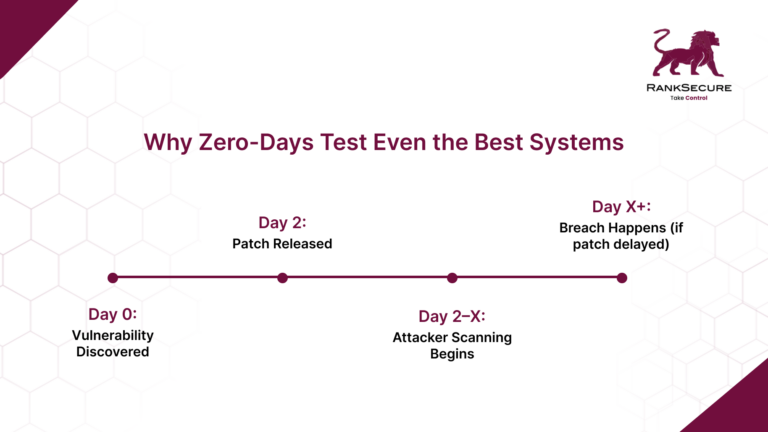Every business claims patching is a priority. Yet year after year, breaches caused by unpatched systems make headlines – often at companies with mature security programs.
Zero-day vulnerabilities expose the gap between policy and execution. These flaws, exploited before a vendor patch is even available, create a race. Once a fix is released, businesses are under pressure to act fast. But in reality, even well-prepared organisations often move too slowly, adding unwanted risk.
The question isn’t whether patching matters.
The real question is: why do businesses that know better still fail to patch quickly when it counts?
What can leadership do to make sure the same mistakes don’t happen in their organisation?
Why Zero-Days Test Even the Best Systems
Zero-day vulnerabilities are difficult to manage because they give no advance warning. By definition, these flaws are unknown to vendors when first discovered. Once exposed, attackers start exploiting before defenders have time to react.
When a patch becomes available, the risk shifts but it doesn’t disappear. Attackers expect delays and look for organisations that are slow to apply fixes. That gap between patch release and patch deployment is where many breaches happen.

The Real Reasons Patch Management Fails
Most companies have patching processes in place. But during a zero-day event, those processes are tested and they often fail. The reasons are rarely technical alone. They’re rooted in operational realities that leadership needs to recognise and address.
1. Operational Bottlenecks
Even critical patches get delayed when teams are worried about breaking production systems. Change freezes, integration dependencies, and complex testing requirements slow everything down. While caution is understandable, security risk rises every day a patch is delayed.
2. Diluted Accountability
In many organisations, no single owner has full responsibility for patch management. Security teams raise the alarm, IT handles deployment, and business units negotiate on timing. This fragmented approach makes it easy for urgent patches to stall without clear oversight.
3. Incomplete Visibility
As infrastructure spreads across on-prem, cloud, and third-party platforms, knowing where vulnerable software sits becomes harder. Patching can only succeed if the organisation has accurate, up-to-date asset inventories. Blind spots are a common reason critical patches don’t reach every system.
4. Risk Trade-Offs
Leadership sometimes faces a difficult choice: apply a patch that might destabilise a critical system, or delay and accept short-term security risk. These trade-offs are rarely made lightly, but when security concerns take a back seat to uptime, exposure grows.
Lessons from High-Profile Failures
Understanding where others went wrong is critical for leadership. These breaches didn’t happen because companies lacked policies or tools, they happened because execution broke down under pressure. Here’s what we can learn from the most well-known failures.
WannaCry (2017)
The WannaCry ransomware attack hit over 200,000 systems in 150 countries, shutting down hospitals, transport systems, and businesses globally. The vulnerability it exploited had been patched by Microsoft two months before the attack. The real issue wasn’t a lack of awareness; it was slow patch deployment across large, complex environments.
Key takeaway for leadership
Patch delays happen even when teams know the risk. Business leaders need to ensure patching is prioritised despite operational pressures and that processes are reviewed regularly to catch rollout gaps before attackers do.
Equifax (2017)
Equifax’s breach exposed sensitive data from 147 million people. The vulnerability exploited was a flaw in Apache Struts – a common open-source framework. A patch had been available for weeks before the attack, but it wasn’t applied. The breach cost Equifax hundreds of millions in penalties and long-term reputational damage.
Key takeaway for leadership
Compliance alone is not enough. Boards and executives must hold teams accountable for timely execution and push for better visibility into which systems rely on third-party components – especially open-source software.
Log4j (2021)
The Log4j zero-day vulnerability created widespread panic because the logging library was embedded in countless applications, many of which businesses didn’t even know were using it. While patches were made available quickly, the bigger challenge was identifying where Log4j was deployed. Some companies spent weeks tracking down all affected systems, leaving them exposed while attackers were already scanning.
Key takeaway for leadership
Asset visibility is a critical weakness in many organisations. Leadership must invest in comprehensive asset management and maintain up-to-date software inventories so that response efforts aren’t slowed by uncertainty when new vulnerabilities are disclosed.
What Leadership Needs to Prioritise
Clear Ownership
Patching requires clear accountability. Leadership should assign responsibility for the full lifecycle: from vulnerability identification to patch deployment and verification.
Faster Decision-Making
In a zero-day event, normal approval chains often slow things down. Build pre-approved response plans that allow critical patches to bypass usual bottlenecks when risk is high.
Asset Visibility
Invest in tools and processes that provide real-time visibility across your infrastructure. You can’t patch what you can’t see.
Test Environments
Stability matters, but delays caused by lack of testing environments are avoidable. Ensure your teams have sandboxes or staging areas where patches can be verified quickly.
Regular Drills
Run patch management drills as part of your broader incident response testing. This highlights gaps before an actual crisis hits and ensures teams are ready to respond under pressure.
Beyond Compliance: The Bigger Picture
Patching is often treated as a technical task or a compliance checkbox. But as discussed above, stakes are far higher. A breach caused by a missed patch doesn’t just impact IT. It brings operational downtime, legal exposure, regulatory penalties, and long-term damage to customer trust.
For boards and executive teams, patch management is a key part of risk governance. It requires ongoing oversight, investment, and cross-team coordination. When it’s treated as routine maintenance, gaps are inevitable. When it’s recognised as a core security control, resilience improves.
The Takeaway
Zero-day vulnerabilities highlight more than technical flaws – they expose weaknesses in how organisations manage security under pressure. Leadership has a direct role to play in ensuring that patching is not just a policy, but a capability that holds up when it matters most.
Building a resilient patch management process means investing in the right tools, enforcing accountability, and preparing your teams to act fast, even when conditions are far from ideal. If your organisation’s current approach depends on everything going smoothly, now is the time to rethink it – before the next zero-day tests your defences.
RankSecure helps organisations strengthen patch management with structured processes, real-time visibility, and expert guidance. To explore how we can support your business in building a more resilient security posture, get in touch with us today.








